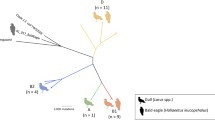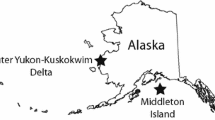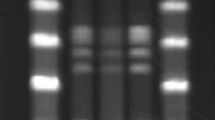Abstract
Environmental pollution with antibiotics and antibiotic resistant bacteria represents a significant ecological problem around the world. In this study, we wanted to identify multiple clinically important genotypes of Escherichia coli (E. coli) in one of the largest populations of white-tailed eagles (Haliaeetus albicilla–H. albicilla) nesting in the protected area of Danube floodplains. This is the first such study of the species, covering the nesting community (20 of 21 active nests) of H. albicilla in one nature reserve. High resistance to fluoroquinolone was detected in one multidrug-resistant E. coli isolate, and this type of resistance was induced by the mutations on topoisomerase genes gyrA, parC, and parE. This isolate also carried resistance genes sul1 and tetB and the virulence gene iutA. Molecular typing by randomly amplified polymorphic DNA (RAPD) in combination with phylogenetic typing revealed high diversity among 11 E. coli isolates. With five different replicon types found (IncFIB, IncFIA, Inc FIC, IncY, and IncI1), the majority of isolates had multi-replicon status with a pronounced capacity of horizontal transfer of resistance and virulence genes. The coexistence of at least two virulence genes linked to development of a pathogenic phenotype and multi-replicon status in three E. coli isolates implies the potential for causing extra-intestinal infections, as well as horizontal transfer of pathogenic genetic determinants in the bacterial community. Resistance to synthetic antibiotics such as fluoroquinolones in an E. coli isolate from white-tailed eagle clearly points to the indirect anthropogenic sources of antibiotic pollution and antibiotic resistant bacteria present in wildlife food chains.
Similar content being viewed by others
Availability of data and material
All data generated or analyzed during this study are included in this published article (and its supplementary information files).
References
Ahlstrom CA, Bonnedahl J, Woksepp H, Hernandez J, Olsen B, Ramey AM (2018) Acquisition and dissemination of cephalosporin-resistant E. coli in migratory birds sampled at an Alaska landfill as inferred through genomic analysis. Sci Rep 8: 7361. https://doi.org/10.1038/s41598-018-25474-w
Alcalá L, Alonso CA, Simón C, González-Esteban C, Orós J, Rezusta A, Ortega C, Torres C (2016) Wild birds, frequent carriers of extended-spectrum β-lactamase (ESBL) producing Escherichia coli of CTX-M and SHV-12 types. Microb Ecol 72:861–869. https://doi.org/10.1007/s00248-015-0718-0
Alm EW, Daniels-Witt QR, Learman DR, Ryu H, Jordan DW, Gehring TM, Santo Domingo J (2018) Potential for gulls to transport bacteria from human waste sites to beaches. Sci Total Environ 615:123–130. https://doi.org/10.1016/j.scitotenv.2017.09.232
Beceiro A, Tomas M, Bou G (2013) Antimicrobial resistance and virulence: a successful or deleterious association in the bacterial world? Clin Microbiol Rev 26:185–230. https://doi.org/10.1128/CMR.00059-12
Bonnedahl J, Drobni M, Gauthier-Clerc M, Hernandez J, Granholm S, Kayser Y, Melhus A, Kahlmeter G, Waldenström J, Johansson A, Olsen B (2009) Dissemination of Escherichia coli with CTX-M type ESBL between humans and yellow-legged gulls in the South of France. PLoS ONE 18:e5958. https://doi.org/10.1371/journal.pone.0005958
Bonnedahl J, Hernandez J, Stedt J, Waldenström J, Olsen B, Drobni M (2014) Extended-spectrum β-lactamases in Escherichia coli and Klebsiella pneumoniae in gulls, Alaska, USA. Emerg Infect Dis 20:897–899. https://doi.org/10.3201/eid2005.130325
Blanco G, Junza A, Segarra D, Barbosa J, Barrón D (2016) Wildlife contamination with fluoroquinolones from livestock: widespread occurrence of enrofloxacin and marbofloxacin in vultures. Chemosphere 144:1536–1543. https://doi.org/10.1016/j.chemosphere.2015.10.045
Blomqvist M, Christerson L, Waldenström J, Lindberg P, Helander B, Gunnarsson G, Herrmann B, Olsen B (2012) Chlamydia psittaci in birds of prey. Sweden Infect Ecol Epidemiology 2:8435. https://doi.org/10.3402/iee.v2i0.8435
Bok E, Kożańska A, Mazurek-Popczyk J, Wojciech M, Baldy-Chudzik K (2020) Extended phylogeny and extraintestinal virulence potential of commensal Escherichia coli from piglets and sows. Int J Environ Res Public Health 6:366. https://doi.org/10.3390/ijerph17010366
Carattoli A, Bertini A, Villa L, Falbo V, Hopkins K, Threlfall EJ (2005) Identification of plasmids by PCR-based replicon typing. J Microbiol Methods 63:19–228. https://doi.org/10.1016/j.mimet.2005.03.018
Citterio B, Andreoni F, Simoni S, Carloni E, Magnani M, Mangiaterra G, Cedraro N, Biavasco F, Vignaroli C (2020) Plasmid replicon typing of antibiotic-resistant Escherichia coli from clams and marine sediments. Front Microbiol 27:1101. https://doi.org/10.3389/fmicb.2020.01101
Clermont O, Bonacorsi S, Bingen E (2000) Rapid and simple determination of the Escherichia coli phylogenetic group. Appl Environ Microbiol 66:4555–4558. https://doi.org/10.1128/AEM.66.10
CLSI (2018) Performance standards for antimicrobial susceptibility testing. 28th ed. CLSI supplement M100. Wayne, PA: Clinical and Laboratory Standards Institute.
Concha C, Miranda CD, Hurtado L, Romero J (2019) Characterization of mechanisms lowering susceptibility to flumequine among bacteria isolated from Chilean salmonid farms. Microorganisms 7:698. https://doi.org/10.3390/microorganisms7120698
Dolejská M, Cizek A, Literak I (2007) High prevalence of antimicrobial-resistant genes and integrons in Escherichia coli isolates from black-headed gulls in the Czech Republic. J Appl Microbiol 103:11–19. https://doi.org/10.1111/j.1365-2672.2006.03241.x
Dolejská M, Bierošová B, Kohoutová L, Literák I, Čížek A (2009) Antibiotic-resistant Salmonella and Escherichia coli isolates with integrons and extended-spectrum beta-lactamases in surface water and sympatric black-headed gulls. J Appl Microbiol 106:1941–1950. https://doi.org/10.1111/j.1365-2672.2009.04155.x
Dolejská M, Literak I (2019) Wildlife is overlooked in the epidemiology of medically important antibiotic-resistant bacteria. Antimicrob Agents Chemother 63:e01167-e1219. https://doi.org/10.1128/AAC.01167-19
Gao P, Mao D, Luo Y, Wang L, Xu B, Xu L (2012) Occurrence of sulfonamide and tetracycline-resistant bacteria and resistance genes in aquaculture environment. Water Res 46:2355–2364. https://doi.org/10.1016/j.watres.2012.02.004
Gargiulo A, Fioretti A, Russo TP, Varriale L, Rampa L, Paone S, De Luca Bossa LM, Raia P, Dipineto L (2018) Occurrence of enteropathogenic bacteria in birds of prey in Italy. Lett Appl Microbiol 66:202–206. https://doi.org/10.1111/lam.12836
Grzywaczewski G, Kowalczyk-Pecka D, Cios S, Bojar W, Jankuszew A, Bojar H, Kolejko M (2017) Tawny owl (Strix aluco) as a potential transmitter of Enterobacteriaceae epidemiologically relevant for forest service workers, nature protection service and ornithologists. Ann Agric Environ Med 24:62–65. https://doi.org/10.5604/12321966.1230732
Guenther S, Grobbel M, Lübke-Becker A, Goedecke A, Friedrich ND, Wieler LH, Ewers C (2010) Antimicrobial resistance profiles of Escherichia coli from common European wild bird species. Vet Microbiol 144:219–225. https://doi.org/10.1016/j.vetmic.2009.12.016
Guenther S, Aschenbrenner K, Stamm I, Bethe A, Semmler T, Stubbe A, Stubbe M, Batsajkhan N, Glupczynski Y, Wieler LH, Ewers C (2012) Comparable high rates of extended-spectrum-beta-lactamase-producing Escherichia coli in birds of prey from Germany and Mongolia. PLoS ONE 7:e53039. https://doi.org/10.1371/journal.pone.0053039
Hám I, Vučanović M (2009) Distribution, breeding success and population size of white-tailed eagle Haliaeetus albicilla in Serbia in 2009. Ciconia 18:15–29. https://pticesrbije.rs/wp-content/uploads/Ciconia18.pdf
Hám, I (2018) Status of white-tailed eagles nests for 2018 (April-June) at the territory of “Gornje Podunavlje”. Internal report of “Vojvodinašume”, unpublished
Hamza D, Dorgham S, Ismael E, El-Moez SIA, Elhariri M, Elhelw R, Hamza E (2020) Emergence of β-lactamase- and carbapenemase-producing Enterobacteriaceae at integrated fish farms. Antimicrob Resist Infect Control 9:67. https://doi.org/10.1186/s13756-020-00736-3
Hassan J, Eddine RZ, Mann D, Li S, Deng X, Saoud IP, Kassem II (2020) The mobile colistin resistance gene, mcr-1.1, is carried on IncX4 plasmids in multidrug resistant E. coli isolated from rainbow trout aquaculture. Microorganisms 8:1636. https://doi.org/10.3390/microorganisms8111636
Janecko N, Pokludova L, Blahova J, Svobodova Z, Literak I (2016) Implications of fluoroquinolone contamination for the aquatic environment—a review. Environ Toxicol Chem 35:2647–2656. https://doi.org/10.1002/etc.3552
Jang J, Hur HG, Sadowsky MJ, Byappanahalli MN, Yan T, Ishii S (2017) Environmental Escherichia coli: ecology and public health implications—a review. J Appl Microbiol 123:570–581. https://doi.org/10.1111/jam.13468
Johnson TJ, Wannemuehle Y, Doetkott C, Johnson SJ, Rosenberger SC, Nolan LK (2008) Identification of minimal predictors of avian pathogenic Escherichia coli virulence for use as a rapid diagnostic tool. J Clin Microbiol 46:3987–3996. https://doi.org/10.1128/JCM.00816-08
Johnson TJ, Nolan LK (2009) Pathogenomics of the virulence plasmids of Escherichia coli. Microbiol Mol Biol Rev 73:750–774. https://doi.org/10.1128/MMBR.00015-09
Johnson TJ, Thorsness JL, Anderson CP, Lynne AM, Foley SL, Han J, Fricke F, McDermott PF, White DG, Khatri M, Stell AL, Flores C, Singer RS (2010) Horizontal gene transfer of a ColV plasmid has resulted in a dominant avian clonal type of Salmonella enterica serovar Kentucky. PLoS ONE 5:e15524. https://doi.org/10.1371/journal.pone.0015524
Kehrenberg C, Werckenthin C, Schwarz S (1998) Tn5706, a transposon-like element from Pasteurella multocida mediating tetracycline resistance. Antimicrob Agents Chemother 42:2116–2118. https://doi.org/10.1128/AAC.42.8.2116
Kehrenberg C, Schwarz S (2001) Occurrence and linkage of genes coding for resistance to sulfonamides, streptomycin and chloramphenicol in bacteria of the genera Pasteurella and Mannheimia. FEMS Microbiol Lett 205:283–290. https://doi.org/10.1111/j.1574-6968.2001.tb10962.x
Kehrenberg C, de Jong A, Friederich S, Cloeckaert A, Schwarz S (2007) Molecular mechanisms of decreased susceptibility to fluoroquinolones in avian Salmonella serovars and their mutant selected during the determination of mutant prevention concentration. J Antimicrob Chemother 59:886–892. https://doi.org/10.1093/jac/dkm072
Kraemer SA, Ramachandran A, Perron GG (2019) Antibiotic pollution in the environment: from microbial ecology to public policy. Microorganisms 7:180. https://doi.org/10.3390/microorganisms7060180
Krone O, Nadjafzadeh M, Berger A (2013) White-tailed Sea Eagles (Haliaeetus albicilla) defend small home ranges in north-east Germany throughout the year. J Ornithol 154:827–835. https://doi.org/10.1007/s10336-013-0951-6
Lagerstrom KM, Hadly EA (2021) The under-investigated wild side of Escherichia coli: genetic diversity, pathogenicity and antimicrobial resistance in wild animals. Proc R Soc B 288:20210399. https://doi.org/10.1098/rspb.2021.0399
McDaniels AE, Rice EW, Reyes AL, Johnson CH, Haugland RA, Stelma GN Jr (1996) Confirmational identification of Escherichia coli, a comparison of genotype and phenotypic assays for glutamate decarboxylase and β-D-glucuronidase. Appl Environ Microbiol 62:3350–3354. https://doi.org/10.1128/AEM.62.9.3350-3354.1996
Milanov D, Fabijan D, Prunić B, Velhner M, Petrović T (2013) Enteric bacteria in fecal samples of Eurasian griffon vultures. Arch Vet Sci 6:45–53. https://niv.ns.ac.rs/e-avm/index.php/e-avm/article/view/153
Mora A, Ortega N, Garcia E, Viso S, Candela MG, Dahbi G, Cuello F, Caro MR (2014) First characterization of Escherichia coli strains isolated from wildlife griffon vulture (Gyps fulvus) in the Southeast of Spain. Open J Vet Med 4:329–333. https://doi.org/10.4236/ojvm.2014.412040
Movalli P, Krone O, Osborn D, Pain D (2018) Monitoring contaminants, emerging infectious diseases and environmental change with raptors, and links to human health. Bird Study 65:S96-S109. https://doi.org/10.1080/00063657.2018.1506735
Ng LK, Martin I, Alfa M, Mulvey M (2001) Multiplex PCR for the detection of tetracycline resistant genes. Mol Cell Probes 15:209–215. https://doi.org/10.1006/mcpr.2001.0363
Oram M, Fisher LM (1991) 4-Quinolone resistance mutations in the DNA gyrase of Escherichia coli clinical isolates identified by using the polymerase chain reaction. Antimicrob Agent Chemother 35:387–389. https://doi.org/10.1128/AAC.35.2.387
Oteo J, Mencía A, Bautista V, Pastor N, Lara N, González-González F, García-Peña FJ, Campos J (2018) Colonization with Enterobacteriaceae-producing ESBLs, AmpCs, and OXA-48 in wild avian species, Spain 2015–2016. Microb Drug Resist 24:932–938. https://doi.org/10.1089/mdr.2018.0004
Pacheco AB, Guth BE, Soares KC, Nishimura L, De Almeida DF, Ferreira LC (1997) Random amplification of polymorphic DNA reveals serotype-specific clonal clusters among enterotoxigenic Escherichia coli strains isolated from humans. J Clin Microbiol 35:1521–1525. https://doi.org/10.1128/JCM.35.6.1521-1525.1997
Perreten V, Boerlin P (2003) A new sulfonamide resistance gene (sul3) in Escherichia coli is widespread in the pig population of Switzerland. Antimicrob Agents Chemother 47:1169–1172. https://doi.org/10.1128/AAC.47.3.1169-1172.2003
Plaza-Rodríguez C, Alt K, Grobbel M, Hammerl JA, Irrgang A, Szabo I, Stingl K, Schuh E, Wiehle L, Pfefferkorn B, Naumann S, Kaesbohrer A, Tenhagen BA (2021) Wildlife as sentinels of antimicrobial resistance in Germany? Front Vet Sci 7:627821. https://doi.org/10.3389/fvets.2020.627821
Probst R, Bogdea L, Bandacu DS, Bohuš M, Cheshmedzhiev S, Gáborik Á, Geissler S, Hodor CV, Ionescu DT, Koev V, Mikuska T, Nagy Z, Parrag T, Rožac V, Schmidt M, Schneider T, Šćiban M, Tatai S, Todorov E, Tomik A, Tucakov M, Váczi M, Frank G (2014) The first comprehensive estimate of the winter population of the white-tailed eagle Haliaeetus albicilla along the Danube. Acrocephalus 35:115–123. https://doi.org/10.1515/acro-2014-0006
Prüller S, Rensch U, Meemken D, Kaspar H, Kopp PA, Klein G, Kehrenberg C (2015) Antimicrobial susceptibility of Bordetella bronchiseptica isolates from swine and companion animals and detection of resistance genes. PLoS ONE 10:e0135703. https://doi.org/10.1371/journal.pone.0135703
Radhouani H, Silva N, Poeta P, Torres C, Correia S, Igrejas G (2014) Potential impact of antimicrobial resistance in wildlife, environment and human health. Front Microbiol 5:23. https://doi.org/10.3389/fmicb.2014.00023
Radović A, Mikuska T (2009) Population size, distribution and habitat selection of the white-tailed eagle Haliaeetus albicilla in the alluvial wetlands of Croatia. Biologia 64:156–164. https://doi.org/10.2478/s11756-009-0011-0
Rozwandowicz M, Brouwer MSM, Fischer J, Wagenaar JA, Gonzalez-Zorn B, Guerra B, Mevius DJ, Hordijk J (2018) Plasmids carrying antimicrobial resistance genes in Enterobacteriaceae. J Antimicrob Chemother 73:1121–1137. https://doi.org/10.1093/jac/dkx488
Ruiz J, Casellas S, Jimenez de Anta MT, Vila J (1997) The region of the parE gene, homologus to the quinolone-resistant determining region of the gyrB gene, is not linked with the acquisition of quinolone resistance in Escherichia coli clinical isolates. J Antimicrob Chemother 39:839–840. https://doi.org/10.1093/jac/39.6.757
Sándor A, Vasile A, Marinov M, Dorosencu A, Domşa C, Kiss J (2014) Nest-site selection, breeding success, and diet of white-tailed eagles (Haliaeetus albicilla) in the Danube delta, Romania. Turk J Zool 39:300–307. https://doi.org/10.3906/zoo-1401-64
Sarowska J, Futoma-Koloch B, Jama-Kmiecik A, Frej-Madrzak M, Ksiazczyk M, Bugla-Ploskonska G, Choroszy-Krol I (2019) Virulence factors, prevalence and potential transmission of extraintestinal pathogenic Escherichia coli isolated from different sources: recent reports. Gut Pathog 11:10. https://doi.org/10.1186/s13099-019-0290-0
Troxler S, Hess C, Konicek C, Knotek Z, Barták P, Hess M (2017) Microdilution testing reveals considerable and diverse antimicrobial resistance of Escherichia coli, thermophilic Campylobacter spp. and Salmonella spp. isolated from wild birds present in urban areas. Eur J Wildl Res 63:68. https://doi.org/10.1007/s10344-017-1125-2
Velhner M, Todorović D, Grego E, Jovičić B, Prunić B, Stojanov I, Kehrenberg C (2018) Fluoroquinolone-resistant and extended-spectrum beta-lactmase producing Escherichia coli from free-living wild animals. Vet Microbiol 223:168–172. https://doi.org/10.1016/j.vetmic.2018.08.011
Velhner M, Todorović D, Novović K, Jovčić B, Lazić G, Kojić M, Kehrenberg C (2021) Characterization of antibiotic resistance in Escherichia coli isolates from black-headed gulls (Larus ridibundus) present in the city of Novi Sad, Serbia. Vet Res Commun. https://doi.org/10.1007/s11259-021-09801-7
Villa L, García-Fernández A, Fortini D, Carattoli A (2010) Replicon sequence typing of IncF plasmids carrying virulence and resistance determinants. J Antimicrob Chemother 65:2518–2529. https://doi.org/10.1093/jac/dkq347
Vila J, Ruiz J, Marco F, Barcelo A, Goñi P, Giralt E, De Anta TJ (1994) Association between double mutation in gyrA gene of ciprofloxacin-resistant clinical isolates of Escherichia coli and MICs. Antimicrob Agent Chemother 38:2477–2479. https://doi.org/10.1128/aac.38.10.2477
Vila J, Ruiz J, Goñi P, De Anta MT (1996) Detection of mutations in parC in quinolone-resistant clinical isolates of Escherichia coli. Antimicrob Agent Chemother 40:491–493. https://doi.org/10.1128/AAC.40.2.491
Vittecoq M, Godreuil S, Prugnolle F, Durand P, Brazier L, Renaud N, Arnal A, Aberkane S, Jean-Pierre H, Gauthier-Clerc M, Thomas F, Renaud F (2016) Antimicrobial resistance in wildlife. J Appl Ecol 53:519–529. https://doi.org/10.1111/1365-2664.12596
Funding
This research was financially supported by a grant from the Ministry of Education, Science and Technological Development of the Republic of Serbia by the Contract of implementation and financing of scientific research work of NIV-NS, Contract No. 451–03-9/2021–14/200031.
Author information
Authors and Affiliations
Contributions
Conceptualization: Gordana Kozoderović, Maja Velhner; methodology: Dalibor Todorović, Maja Velhner; investigation: Gordana Kozoderović, Dalibor Todorović, Brankica Kartalović, Milan Đilas; data curation: Dalibor Todorović; writing—original draft preparation: Gordana Kozoderović; writing—review and editing: Dalibor Todorović, Maja Velhner, Milan Đilas, and Brankica Kartalović; funding acquisition: Maja Velhner; resources: Gordana Kozoderović, Dalibor Todorović, Maja Velhner.
Ethics declarations
Ethics approval
The collection of samples has been conducted as per the guidelines of the national and provincial institutions, according to national legislations for protected species (Ministry of Environmental Protection of the Republic of Serbia: Permission for research of faeces samples of highly protected species of white-tailed eagle (Haliaeetus albicilla) for scientific investigation purposes, number 353–01-1030/2018–04; Institute for Nature Conservation of Vojvodina Province: Expert opinion of the possibility of collection of faeces of white-tailed eagle (Haliaeetus albicilla) in SNR “Gornje Podunavlje” for the purpose of bacteriological and parasitological research, number 03–1038/2). According to the IUCN Red List of Threatened species, the conservation status of Haliaeetus albicilla is of “least concern” (LC).
Consent to participate
Not applicable.
Consent for publication
Not applicable.
Conflict of interest
The authors declare no competing interests.
Additional information
Publisher's Note
Springer Nature remains neutral with regard to jurisdictional claims in published maps and institutional affiliations.
Supplementary Information
Below is the link to the electronic supplementary material.
Rights and permissions
About this article
Cite this article
Kozoderović, G., Todorović, D., Đilas, M. et al. White-tailed eagles (Haliaeetus albicilla) in protected Danube wetlands as carriers of Escherichia coli with resistance and virulence genes. Eur J Wildl Res 67, 103 (2021). https://doi.org/10.1007/s10344-021-01547-6
Received:
Revised:
Accepted:
Published:
DOI: https://doi.org/10.1007/s10344-021-01547-6




